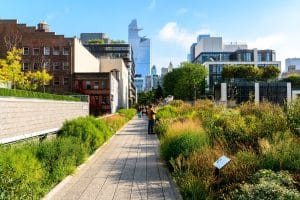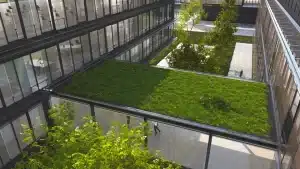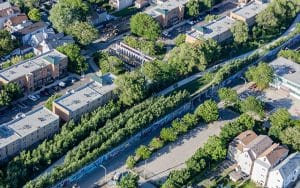What is Green Stormwater Infrastructure? An Essential Guide
Intro
The face of increasing urbanization and the challenges it poses for the natural environment, innovative solutions like green stormwater infrastructure (GSI) are emerging as pivotal for sustainable urban development. But what is green stormwater infrastructure? Essentially, it refers to systems and practices that use or mimic natural processes to manage stormwater runoff, reduce flooding, improve water quality, and enhance community well-being. Green infrastructure reduces pollution by removing sediments, nutrients, and contaminants from stormwater runoff, improving water quality. This approach contrasts with traditional ‘gray’ infrastructure, which primarily involves concrete channels and piped drainage systems. Green infrastructure aims to create a harmonious balance between urban development and the natural environment, offering multiple benefits not only for our ecosystem but for the communities that inhabit them.
Understanding Green Stormwater Infrastructure and Its Importance
Green stormwater infrastructure (GSI) integrates a variety of strategies designed to manage stormwater runoff in a more natural and effective way compared to traditional methods. By utilizing elements such as rain gardens, permeable pavements, green roofs, and rainwater harvesting systems, GSI aims to tackle the increasing challenge of urban runoff and water pollution head-on. Stormwater planters remove up to 90% of pollutants. These systems are engineered to capture, absorb, and filter rainwater right at its source, significantly minimizing the amount of runoff that ends up in sewers or bodies of water.
The critical role of GSI in urban areas extends beyond mere water management; it is a cornerstone for sustainable urban planning, aiming to reverse the environmental degradation brought about by extensive urbanization. As cities expand, the strain on traditional stormwater systems intensifies, leading to polluted waterways and overstressed infrastructure. GSI offers a solution that not only addresses these pressing issues but also supports the regeneration of local ecosystems. By integrating natural processes into the fabric of urban environments, GSI helps safeguard water quality, protects against flooding, and contributes to the overall resilience of cities against the impacts of climate change. Its implementation stands as a testament to a collective shift towards more environmentally conscious urban development practices, marking a significant stride in the pursuit of sustainability and ecological balance within our urban landscapes.
systems intensifies, leading to polluted waterways and overstressed infrastructure. GSI offers a solution that not only addresses these pressing issues but also supports the regeneration of local ecosystems. By integrating natural processes into the fabric of urban environments, GSI helps safeguard water quality, protects against flooding, and contributes to the overall resilience of cities against the impacts of climate change. Its implementation stands as a testament to a collective shift towards more environmentally conscious urban development practices, marking a significant stride in the pursuit of sustainability and ecological balance within our urban landscapes.
Reducing Urban Runoff and Preventing Flooding
At the heart of green stormwater infrastructure’s myriad advantages lies its proficiency in curbing urban runoff and alleviating the threat of flooding—a pressing concern in many rapidly urbanizing regions. Traditional urban landscapes, dominated by impervious materials like concrete, exacerbate runoff by inhibiting natural water infiltration into the earth. This not only heightens the risk of urban flooding but also places an undue strain on municipal stormwater management systems. Conversely, green infrastructure interventions such as bio-retention cells, permeable paving, and swales act as a sponge, absorbing rainwater where it falls.
This natural absorption process significantly reduces the volume of runoff, directly diminishing the pressure on sewers and mitigating potential flooding events. These green solutions offer a stark contrast to conventional methods by facilitating the gradual release of stored water back into the environment, either through evaporation or percolation into the soil, thereby recharging groundwater reserves and maintaining the natural hydrological cycle.
The strategic implementation of these systems not only prevents the immediate and costly impacts of flooding but also addresses long-term water management challenges, making our urban areas more resilient and sustainable in the face of climate change and population growth. By prioritizing green infrastructure, cities can transform their approach to stormwater management, turning potential hazards into opportunities for enhancing urban ecology and resilience. Over 40,000 specific projects and awards have been announced under the Bipartisan Infrastructure Law funding
Improving Water Quality Through Natural Filtration
One of the standout features of green stormwater infrastructure (GSI) is its capacity to significantly enhance water quality through the process of natural filtration. Green infrastructure reduces pollution by removing sediments, nutrients, and contaminants from stormwater runoff, improving water quality. As stormwater traverses through GSI components like rain gardens, vegetated swales, and bio-retention areas, it undergoes a remarkable transformation. The layers of soil and plant life within these systems act as a natural filter, capturing and degrading pollutants that would otherwise enter our waterways. This includes common urban contaminants such as pesticides, sediments, and nutrients from fertilizers, which are known to contribute to waterway degradation and eutrophication.
The mechanism of filtration in GSI is both simple and effective. The physical structure of soil and plant roots traps particulate matter, while microbial processes within the soil matrix break down pollutants, rendering them harmless. This bioremediation aspect is crucial for maintaining the health of aquatic ecosystems downstream and ensuring that water bodies remain safe for wildlife and human activities.
Moreover, the strategic use of specific plants and substrates can target particular pollutants, offering tailored solutions to unique urban water quality challenges. This aspect of green infrastructure underscores the versatility and adaptability of GSI systems in urban water management.
By leveraging the power of nature, green stormwater infrastructure provides a sustainable and efficient means to address urban water pollution, underscoring its importance in contemporary urban environmental management strategies.
Enhancing Urban Biodiversity and Ecosystem Services
The integration of green stormwater infrastructure (GSI) into urban landscapes does more than manage water; it serves as a catalyst for biodiversity and the enhancement of ecosystem services. By incorporating elements such as green roofs, rain gardens, and tree plantings, urban areas become refuges for various plant and animal species that might otherwise be marginalized by city development. This increased green space offers essential habitats, facilitating urban wildlife corridors and supporting native species, thereby strengthening the ecological fabric of our cities.
Moreover, the presence of diverse plant life within GSI components plays a crucial role in maintaining ecological balance. Vegetation attracts beneficial insects, birds, and other wildlife, promoting pollination and contributing to the health and resilience of urban ecosystems. These green spaces are not just beneficial for wildlife; they provide crucial ecosystem services such as air purification, carbon storage, and temperature regulation, directly contributing to the mitigation of some urban environmental issues.
The strategic placement and design of GSI elements can further magnify these benefits. For example, green corridors can connect fragmented habitats, allowing species to move freely and safely across urban landscapes, thus preserving biodiversity. Additionally, the use of native plants in GSI projects can bolster local ecosystems, ensuring that these installations are not only functional in terms of stormwater management but are also ecologically integrated into their surroundings.
Through these concerted efforts, GSI becomes a powerful tool in the quest to rewild urban spaces, offering a symbiotic relationship between city development and the natural world, enriching both biodiversity and the human experience in the urban context.
Contributing to Urban Heat Island Mitigation
The phenomenon of urban heat islands presents a significant challenge in densely populated areas, where temperatures can soar due to the abundance of heat-absorbing materials like concrete and asphalt. The strategic incorporation of green stormwater infrastructure (GSI) offers a natural solution to this problem. Through the installation of green roofs and the expansion of urban tree canopies, GSI plays a crucial role in cooling cityscapes. These elements work by providing natural shade and facilitating the process of evapotranspiration, wherein water is transferred from the earth to the atmosphere by evaporation from the soil and other surfaces and by transpiration from plants. This not only results in a direct cooling effect but also contributes to a more regulated urban climate over time.
The benefits of tackling the urban heat island effect with green infrastructure extend beyond mere temperature reduction. By lowering urban temperatures, GSI helps decrease the demand for air conditioning in surrounding buildings, leading to lower energy consumption and reduced greenhouse gas emissions. This approach not only addresses the symptoms of the urban heat island effect but also contributes to a broader strategy for energy efficiency and sustainability in urban areas. Through the thoughtful integration of green roofs, tree plantings, and other GSI components, cities can harness the cooling power of nature to create more comfortable and sustainable environments for their residents.
Promoting Community Well-Being and Aesthetic Value
Green stormwater infrastructure (GSI) significantly enhances urban environments by fostering communal spaces that encourage social interaction and physical well-being. By integrating features such as rain gardens, green roofs, and vegetated pathways, GSI transforms urban spaces into areas of natural beauty and tranquility, breaking up the monotony of concrete and steel.
These green spaces become focal points for community engagement, offering places for relaxation, play, and social gatherings. The psychological benefits are profound; access to natural areas has been shown to reduce stress levels, improve mood, and enhance overall mental health. Additionally, the incorporation of aesthetically pleasing green elements into cityscapes can elevate property values and attract businesses, contributing to the economic vibrancy of neighborhoods.
The role of GSI extends to creating safer, more walkable communities. Pedestrian-friendly pathways lined with vegetation not only encourage residents to engage in physical activity but also calm traffic, reducing accidents and promoting a more livable urban environment. This focus on pedestrian infrastructure can foster a sense of community ownership and stewardship, encouraging local involvement in maintenance and sustainability efforts.
Moreover, the design and maintenance of GSI projects provide opportunities for community education and involvement. Educational programs can raise awareness about the importance of sustainable water management and environmental stewardship, engaging citizens in the long-term health of their community. Through these various avenues, green stormwater infrastructure plays a pivotal role in not just managing stormwater, but in cultivating vibrant, healthy, and interconnected communities.
Economic Advantages of Green Stormwater Infrastructure
The financial benefits of integrating green stormwater infrastructure (GSI) into urban development strategies are multifaceted, presenting a compelling case for municipalities and developers alike. Unlike conventional gray infrastructure, which often demands significant capital investment in drainage systems and ongoing maintenance, GSI offers a more cost-efficient alternative. The natural systems employed in GSI, such as rain gardens and permeable pavements, require less expensive materials and can be less labor-intensive to install. Over time, these green solutions tend to incur lower maintenance costs, thanks in part to the self-sustaining nature of the vegetation and soils used.
Beyond the direct cost savings on installation and upkeep, GSI provides substantial economic value by mitigating flood damage, a common and costly urban challenge. By absorbing and managing stormwater onsite, GSI reduces the burden on municipal stormwater systems and decreases the likelihood of flood events that can cause extensive property damage and economic disruption. This risk reduction translates into lower insurance premiums for property owners and decreased emergency response and repair expenditures for cities.
Additionally, the aesthetic and recreational enhancements associated with GSI contribute to increased property values and can stimulate local economies by attracting businesses and tourists. Green spaces are known to enhance the appeal of urban areas, making neighborhoods more desirable for residents and visitors alike. This increased attractiveness can spur economic development, creating jobs and fostering a vibrant community atmosphere. Through these economic channels, GSI demonstrates its capacity not only to support environmental sustainability but also to bolster urban economic resilience and prosperity.
neighborhoods more desirable for residents and visitors alike. This increased attractiveness can spur economic development, creating jobs and fostering a vibrant community atmosphere. Through these economic channels, GSI demonstrates its capacity not only to support environmental sustainability but also to bolster urban economic resilience and prosperity.
The Path Forward for Green Stormwater Infrastructure
Embracing green stormwater infrastructure (GSI) is crucial for the future of urban development, as cities expand and environmental challenges intensify. The journey ahead necessitates a collective effort among government bodies, urban developers, and the community to weave GSI into the fabric of urban planning. Successful initiatives in diverse locales, from the vibrant streets of Seattle to the bustling urban sprawl of New York, underscore the versatility and efficacy of GSI across various climates and cityscapes.
According to the Stormwater Training Center, a key to advancing GSI is fostering an environ

ment of innovation and collaboration. By sharing knowledge, resources, and best practices, stakeholders can overcome common barriers to implementation, such as funding constraints and regulatory hurdles. Engaging the public through educational outreach and participatory design processes can cultivate a sense of ownership and stewardship among residents, ensuring the long-term success and maintenance of GSI projects.
Furthermore, integrating GSI into local and regional policy frameworks is essential. Incentivizing green development through tax breaks, grants, and regulatory flexibility can encourage developers and property owners to adopt GSI measures. At the same time, establishing clear guidelines and standards for GSI implementation ensures consistency and effectiveness across projects.
As we navigate the complexities of urban expansion and environmental preservation, GSI emerges as a beacon of sustainable development. Through concerted effort and strategic planning, we can harness the benefits of GSI to create resilient, thriving urban environments that are well-equipped to meet the challenges of the 21st century and beyond.
